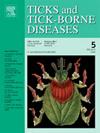综述了鸟类作为蜱虫传播者的作用,特别强调了透明体和克里米亚-刚果出血热病毒
IF 3.4
2区 医学
Q2 INFECTIOUS DISEASES
引用次数: 0
摘要
边缘透明体和斑疹透明体是具有高度医学重要性的蜱类,主要是因为它们能够传播克里米亚-刚果出血热病毒。虽然边缘芽孢杆菌是南欧的地方病,但rufipes只在非洲维持着可存活的种群。然而,在欧洲非流行地区经常发现这两种蜱虫的成年标本。这种现象主要是由鸟类迁徙造成的,在迁徙过程中,这两种宿主蜱虫可以远距离传播。为了加强我们对鸟类在透明体蜱传播中的作用及其对克里米亚-刚果出血热病毒被动传播的潜在贡献的理解,编写了这篇小型综述。通过综合相关文章,该摘要旨在有助于更准确地理解这一现象。根据我们的研究结果,从生态流行病学的角度来看,鸟类传播的透明瘤物种与克里米亚-刚果出血热之间的关系非常复杂。更好地了解候鸟与病毒之间的直接联系,以及病毒持续存在和传播的机制,对于制定有效的风险评估战略至关重要。本文章由计算机程序翻译,如有差异,请以英文原文为准。
A review on the role of birds as disseminators of ticks, with special emphasis on Hyalomma species and Crimean-Congo haemorrhagic fever virus
Hyalomma marginatum and Hyalomma rufipes are tick species of high medical importance, primarily due to their ability to transmit the Crimean-Congo haemorrhagic fever virus. While H. marginatum is endemic in Southern Europe, H. rufipes maintains viable populations exclusively in Africa. Nevertheless, adult specimens of both tick species are frequently detected in non-endemic regions of Europe. This phenomenon is primarily driven by bird migration, during which these two-host ticks can be transported over great distances. To enhance our understanding of the role of birds in the dispersal of Hyalomma ticks and their potential contribution to the passive transmission of Crimean-Congo haemorrhagic fever virus, this mini review was compiled. By synthesizing relevant articles, the summary aims to contribute to a more precise understanding of the phenomenon. According to our findings, the relationship between bird-transported Hyalomma species and Crimean-Congo haemorrhagic fever is highly complex from an eco-epidemiological perspective. A better understanding of the direct association between migratory birds and the virus, as well as the mechanisms of viral persistence and transmission, is essential for developing effective risk assessment strategies.
求助全文
通过发布文献求助,成功后即可免费获取论文全文。
去求助
来源期刊

Ticks and Tick-borne Diseases
INFECTIOUS DISEASES-MICROBIOLOGY
CiteScore
6.90
自引率
12.50%
发文量
185
审稿时长
6-12 weeks
期刊介绍:
Ticks and Tick-borne Diseases is an international, peer-reviewed scientific journal. It publishes original research papers, short communications, state-of-the-art mini-reviews, letters to the editor, clinical-case studies, announcements of pertinent international meetings, and editorials.
The journal covers a broad spectrum and brings together various disciplines, for example, zoology, microbiology, molecular biology, genetics, mathematical modelling, veterinary and human medicine. Multidisciplinary approaches and the use of conventional and novel methods/methodologies (in the field and in the laboratory) are crucial for deeper understanding of the natural processes and human behaviour/activities that result in human or animal diseases and in economic effects of ticks and tick-borne pathogens. Such understanding is essential for management of tick populations and tick-borne diseases in an effective and environmentally acceptable manner.
 求助内容:
求助内容: 应助结果提醒方式:
应助结果提醒方式:


